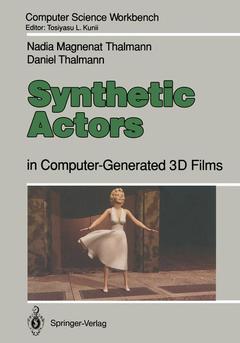Description
Synthetic Actors, Softcover reprint of the original 1st ed. 1990
in Computer-Generated 3D Films
Coll. Computer Science Workbench
Language: French
Publication date: 12-2011
129 p. · 17x24.2 cm · Paperback
129 p. · 17x24.2 cm · Paperback
Description
/li>Contents
/li>
This book presents the making of computer-generated films using three-dimensional synthetic actors. It is based mainly on the production of the film Rendez-vous a Montreal, an animated film that uses advanced computer techniques to achieve such effects as reincarnating film stars Humphrey Bogart and Marilyn Monroe. The main purpose of Rendez-vous a Montreal is to show that true synthetic actors can be created. This fllm represents a technological breakthrough which opens up new vistas in motion pictures, television, and advertising. With this technique, it will now be possible to produce short fllms or motion pictures featuring any celebrity in any situation. The book explains in detail how such a film can be produced using numerous drawings and color pictures. In particular, the following topics are presented: - Preparation of object construction: documentation search, and plaster models preparation - Object construction: digitizing and modeling - Body animation - Hand animation and object grasping - Facial animation: expressions, phonemes and emotions - Choreography: decors, actors, cameras, and lights - Realism: colors, lights, shading, shadows, and textures - Image recording: special effects Finally, an extensive appendix describes in detail the HUMAN FACTORY system.
1. How to Make a Film with Synthetic Actors.- 1.1 Computer Animation and Synthetic Actors.- 1.2 The Film Rendez-vous à Montréal.- 2. Three-Dimensional Construction of Synthetic Actors.- 2.1 Planning and Preparation of Models for 3D Reconstruction.- 2.2 How to Enter the Shapes.- 2.3 Photographs.- 2.4 Object Composition.- 3. Human Prototyping.- 3.1 Local Transformations of Existing Synthetic Actors.- 3.2 Shape Interpolation Between Human Faces.- 4. Body Animation of Synthetic Actors.- 4.1 Principles of Body Animation.- 4.2 Skeleton Definition and Positioning.- 4.3 Skeleton Animation.- 5. Hand Animation, Object Grasping, and Foot Animation.- 5.1 Hand Skeleton and Surface.- 5.2 Hand Animation.- 5.3 Object Grasping and Manipulating.- 5.4 Foot Animation.- 6. Facial Animation of Synthetic Actors.- 6.1 A Three-Level Approach to Facial Animation.- 6.2 The Facial Parameters.- 6.3 The Expressions: Phonemes and Emotions.- 6.4 The Script Level.- 6.5 A Script Example from the Film Rendez-vous à Montréal.- 6.6 Interpolating Facial Parameters and Expressions Between Two Different Human Faces.- 7. Color, Reflectance, Transparency, and Texture.- 7.1 Colors.- 7.2 Reflectance.- 7.3 Transparency and Textures.- 8. Cameras, Lights, and Shadows.- 8.1 Cameras.- 8.2 Lights.- 8.3 Shadows.- 9. Choreography.- 9.1 Decors and Actors.- 9.2 Cameras and Lights.- 9.3 Camera and Light Paths.- Appendix: The HUMAN FACTORY Software.- A. 1 The Architecture of the HUMAN FACTORY System.- A.2 The DIGIT3D Program.- A.3 The SABRINA System.- A.4 The BODYJPARTS System.- A.5 The BODY_MOVTNG System.- A.6 The FACE_MOVING System.- A.7 The M3RANIM System.- A.8 The DISPLAY Program.
© 2024 LAVOISIER S.A.S.




